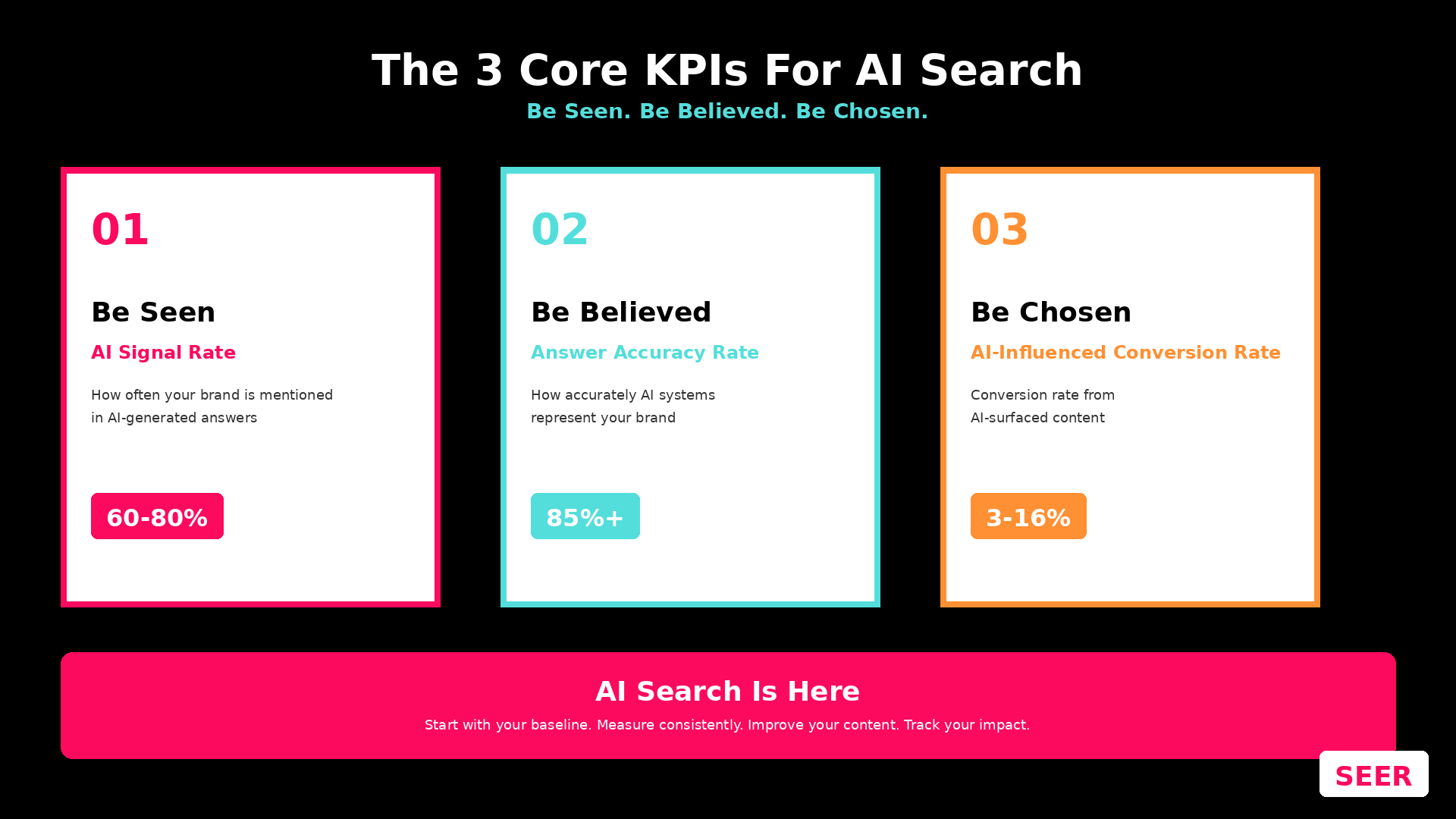Seerfest 2022 Session Recap

Marketing measurement has long been a hot topic of discussion amongst companies of all shapes and sizes.
While access to data has come a long way since the days of “Half the money I spend on advertising is wasted; the trouble is I don’t know which half,” these recent stats show there’s still a lot to be desired when it comes to marketing measurement:
- 63% of Digital Marketers don’t feel confident in their ROI measurements
- 40% of marketing leaders believe that marketing, sales, and finance teams aren’t aligned on what successful ROI looks like
- 31% of B2B professionals believe that sales cycles are getting longer
In one of the first sessions at Seerfest 2022, Vice President of Analytics & Insights, Heather Aeder thoroughly detailed an approach that helps eliminate the ambiguity of marketing performance – a Closed Loop Marketing Measurement System.
While most marketers look at top-of-funnel metrics like sessions or Cost Per Lead, Closed Loop follows the buyer throughout the entire sales cycle and allows marketers to understand which efforts actually generated revenue for their company.
As Heather demonstrated early on, you can draw very different (and potentially costly) conclusions in each scenario:


So let’s dig into Closed Loop Measurement Systems - what they are, what types exist, and why it can be the sweetest part of your entire marketing strategy.
What is Closed Loop Marketing?
NOTHING!
According to Aeder:
"There’s nothing special about Closed Loop Marketing. I actually believe this is a misnomer. Your marketing doesn’t change; your marketing stays the same. How you invest in your marketing changes when you have a Closed Loop Measurement System in place."
A Closed Loop System is the combination of a Digital Measurement System and a Customer Relationship Management (CRM) system:
- Digital Measurement System: This can take the form of a web analytics solution (e.g. Google Analytics, Adobe Analytics) or a marketing automation tool (e.g. Hubspot, Marketo)
- Customer Relationship Management (CRM) system: As the name implies, this is where a company manages their relationships with customers, both active and prospective. The CRM is a database of all relevant contacts and activities throughout the sales cycle.
Now that we were clear on the terminology, we could talk about what was needed to achieve Closed Loop. The type of business you have and the metrics you need to measure success determine the complexity of Closed Loop System needed.
3 Flavors of Closed Loop
To teach us about the different levels of Closed Loop Systems, Heather took us to the ice cream emporium.
On the menu: 3 flavors - Vanilla, Chocolate Chip, and Rocky Road.
Vanilla
This first level of Closed Loop System is the most straightforward to implement, as all marketing activities and transactions occur online (Heather referred to this as a “fully digital ecosystem”).
A visitor comes to your website and simultaneously becomes a lead and a customer when they choose to purchase a product(s) from your site. Given the centralized nature of the customer journey, this level of Closed Loop can be achieved with a single tool, although you have a choice between an analytics solution or an attribution tool:
- Analytics solution: This option tracks on-site behavior and allows you to dig into user behaviors and the various microconversions that occur on the path to purchase
- Attribution tool: This route focuses on the multiple marketing touchpoints that a user interacts with before becoming a customer, allowing you to attribute value to every channel that plays a role.
So who can utilize this type of Closed Loop System? This approach works for direct-to-consumer (D2C) eCommerce brands and mainly requires a focus on comprehensive tracking of all website transactions.
Most companies can stand up a "Vanilla" Closed Loop System in 90 days.
Chocolate Chip
A more complex customer journey requires a more complex flavor of Closed Loop.
For those companies that focus the majority of their marketing efforts online but complete their sales cycle offline (e.g. hospitals, universities, insurance companies), Chocolate Chip is the way to go. A visitor to your site becomes a lead when they fill out a form, like a request for information or application. The lead will then go through some level of qualification to become a sales-qualified lead (SQL), which will then be handed off to a sales rep to be guided to a product purchase or signed contract.
Since the visitor becomes a lead and a customer at different times, we need to join our Digital Measurement System with our CRM in order to see the entire process.
The key here is to have a bilateral data flow, where data flows from both the Digital Measurement Solution to the CRM and vice versa. Many of these platforms will have native integrations with standard data points for Closed Loop, though some companies will opt to skip this in favor of sending data from both platforms to a data warehouse and visualizing the combined data sets in a tool like Google Data Studio or Tableau for reporting purposes.
Which is why a good portion of the project will be spent requirements gathering -- ensuring that you have the proper systems and tracking in place to follow the entire customer journey between your website and sales team.
A "Chocolate Chip" Closed Loop System can take between 3-6 months.
Rocky Road
Now, what if some users never interact with you digitally before becoming a customer - can you still have a Closed Loop System then? Yes, with the richest and most complex flavor, Rocky Road!
For B2B Software companies and the like, some marketing efforts (e.g. trade shows, direct mail) connect users directly with a salesperson.
To achieve Closed Loop in this scenario, you still need to combine a Digital Measurement System with a CRM system, although many will opt for a Marketing Automation tool over a web analytics tool as you can run both your online and offline marketing efforts through it.
While a Marketing Automation tool won’t provide the granular level of detail for making optimizations at the keyword level (you’ll still rely on the engines for that), it’s ideal for providing a high-level view that helps you determine where to invest your marketing $$.
Rocky Road level Closed Loop can be done using either the existing integrations between platforms or the option to blend data in a Data Warehouse as mentioned earlier. The determining factor is whether the standard integration includes all the dimensions and metrics that are important for measuring your business.
As the most complex Closed Loop System, "Rocky Road" can take up to 6-12 months or longer.
Closed Loop “Cheat Sheet”

Why Closed Loop is So Sweet
A Closed Loop Measurement System can be challenging and time-consuming to implement, so why bother?
- Improved ROAS: In the words of the great Peter Drucker, “If you can’t measure it, you can’t improve it.” With a Closed Loop System in place, you’ll have a direct line of sight into your ROAS and can focus your efforts on the best performing channels or campaigns.
- Shorter sales cycle: Once you know which channels or campaigns perform the best and you align your strategy with those, you’ll generate much more qualified leads that turn into customers faster.
- Less friction between sales and marketing: With everyone looking at the same scoreboard, you’ll notice the old squabbles over “poor lead quality” or “leads not getting worked” disappear from your company’s lexicon. One team, one dream!
Key Takeaways
Heather put the cherry on top of the presentation with the following takeaways:
- Closed Loop Measurement Systems follow the buyer and connect online/offline marketing tactics to online/offline conversions
- Closed Loop Report and Analysis enable marketers to optimize their spend based on ROAS vs. top of funnel metrics like Cost Per Lead
- Your system flavor depends on the type of marketing you deploy and where your conversions occur
- Getting started with Closed Loop Measurement requires investments: dollars, labor, and time



